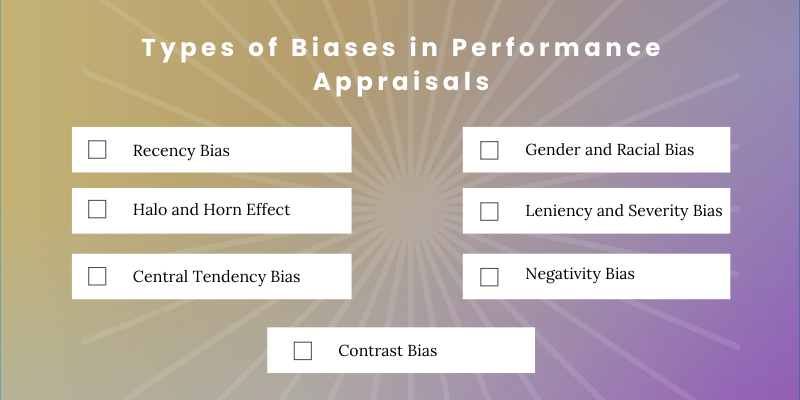This article gives ideas and insights on how to improve your performance management process by identifying and avoiding bias in performance appraisals.
“It’s not at all hard to understand a person; it’s only hard to listen without bias.”
According to survey results from Fortune 1,000 companies, 66% employees are dissatisfied with their performance evaluations. Among these, 71% thought performance evaluations were unfair.
The goal of performance appraisals is more than just evaluating employee performance and providing appraisal scores. Employee reviews, in fact, help in identifying skill development needs of employees and rewarding the top performers for their valuable contributions.
As much as we would like the employee evaluations to be holistic and transparent, are we actually really observing fairness and objectivity in performance reviews? Or, are the managers falling prey to bias in performance appraisals? Furthermore, do Human resource professionals have action plans or strategies in place, on how to avoid bias in performance appraisals?
Types of Biases in Performance Appraisals
During performance reviews, every manager uniquely evaluates and scores employees on multiple performance parameters. Yet, some types of judgment errors or biases occur, even if they are unconscious.
Below is a list of few commonly occurring bias and rating errors. Let us understand them and learn the tips on avoiding bias in performance appraisals.

Recency Bias
This is the most commonly occurring bias. Recency bias in performance appraisal happens when you judge an employee on the basis of the employee’s most recent performance. This happens when assessments are usually done once a year rather than on a continuous basis.
Hence the reviews are neither fair or accurate and do not reflect the actual employee performance.
Halo and Horn Effect
When the rater creates an overall positive impression of an employee and inflates the ratings, it is known as the halo effect. It can happen due to the consequence of a manager having affinity or similarity bias with some employees. The Horn effect is when a manager finds one negative aspect of an employee and deflates the ratings in all areas.
These types of biases in performance appraisals can not only lead to unfair assessments, but at the same time they can impact the objectivity of the performance reviews. Thus, it becomes important to overcome these performance appraisal errors.
Central Tendency Bias
The central tendency bias in performance appraisal is the tendency of the manager to evaluate the majority of the employees as average. An example would be, that you rate most of the employees as “3” on a 5 point rating scale. As a result, it becomes difficult to identify actual data, as the appraisal scores are close to average.
In fact, HR and leadership find it challenging to identify employee’s strengths and weaknesses. This can also impact the low performers as they do not get any idea on their areas of improvement.
Hence, it becomes imperative to think of ways to avoiding bias in performance appraisals.
Gender and Racial Bias
We have seen from research that men are 3x more likely to be rated as high-potential employees than their equally capable women colleagues. Kieran Snyder’s study has found that women are significantly more likely to receive critical feedback vs. male colleagues. Similarly, it has been seen that white men are 2x more likely to be rated as high-potential employees than black men. These gender and racial bias in performance reviews are significantly seen in organizations.
Leniency and Severity Bias
When the supervisor’s rating patterns shift from ‘strict’ to ‘lenient’, it leads to differences in appraisal scores among employees functioning at the same levels. As a result, the subordinates are given low or high ratings. Hence, the scores are wrong, and the comparisons are likewise inaccurate.
Negativity Bias
When the negative information dominates our thoughts, we tend to make negative decisions rather than balanced ones. For example, if an employee has previously failed, our brain still creates a negative bias even if that employee’s performance has improved. Professional development is hampered by negativity bias.
Contrast Bias
This bias occurs when the manager compares the performance of one employee with the performance of other employees and assigns ratings accordingly. It is important for managers to overcome this bias because each employee deserves to be evaluated based on their own merits rather than in comparison to other employees.
Why do Experts Suggest Avoiding Bias in Performance Appraisals?
Biases and rating errors in performance evaluations can have a negative impact on workplace productivity. Not to mention, that an unfair performance review can demotivate top performers from achieving their objectives. Unfair evaluations harm company relations, because top performers believe their efforts are not sufficiently recognized and rewarded.
Yet there may be employees who are rewarded for their average performance due to favoritism or rating errors.
It becomes important for every HR department to identify and find ways to avoid bias in performance evaluation. Supervisors, managers and HR should all work together in avoiding biases in performance appraisals. They should ensure that performance reviews remain fair and employees remain motivated throughout the process.
Reducing Risks and Avoiding Bias in Performance Appraisals

You can get a few tips here on how to overcome performance appraisal errors.
Clear Work Expectations
One of the best ways of avoiding bias in performance appraisals is to define a standard criteria against which an employee’s performance is evaluated. As a result, managers should decide and set employee goals at the start of the performance period. They must leave no room for surprises. Once the goals are clearly outlined in front of employees, there are no chances of rating errors.
In this way, managers have a point of reference to rate employees’ performance for a specific period.
Performance Notes Throughout the Year
Avoid recency bias in appraisals with the help of ongoing performance documentation.
As so much happens in a year, hence it is necessary to keep track of employee performance. Managers can use tools to easily identify employee achievements, problems, missed deadlines, absenteeism and other issues. In fact, managers can refer to these performance notes during the review to provide accurate ratings to employees.
Ongoing Constructive Feedback
The first thing that managers should remember is to meet their employees regularly and carry out performance conversations to understand their problems. Do not let remote working affect the frequency of feedback sessions. HR tools can assist in managing remote teams and carrying out effective performance reviews remotely.
The managers are advised to provide constructive feedback to employees on a regular basis for improving performance and avoiding bias in performance appraisals. This will help in easily identifying employee strengths, weaknesses and areas of improvement in a timely manner.

With regular feedback you can also make sure that employees know how they are performing at the workplace. This way, employees do not feel like they are being criticized. You can reduce bias with timely, positive feedback and development plans.
Avoid Open Box Review
Managers often receive open-ended questions without any training on how to effectively complete performance evaluations.
According to a McKinsey survey, less than 30 percent of employees agree that their managers are good coaches.
Hence, you can set up a systematic performance assessment process in the organization. In fact, you can train your managers to find out measurable results from a performance assessment. In this way, managers can remain focused on providing positive feedback and developing employee skills. This method helps to overcome the halo and horn effect in performance evaluation.
Normalization of Performance Scores
Normalization is a method used to balance the difference in appraisal scores and make the assessments fair. Companies aim to simplify appraisal scores in order to reduce manager biases during performance evaluations. This way you can contribute to greater objectivity in the process. With this method you can also remove leniency and severity bias.
Automate Performance Appraisal
Last but not the least, implement a cloud-based performance appraisal software to avoid bias and rating errors. An online appraisal software helps to easily keep track of performance notes, provide comparative ratings to employees and create multiple appraisal plans for different employee groups.
Additionally, you can increase the effectiveness of the appraisal process and get yearly performance reports. This brings transparency and objectivity in the review process. In short, you can evaluate performance fairly to engage and motivate top performers.
Concluding Thoughts
The absence of a systematic performance evaluation process often becomes a problem. Therefore, experts suggest we have a well-planned appraisal process to help managers and HR examine past appraisal data and make informed decisions. In fact, you can use automated performance management software to accurately calculate appraisal score variations and avoid bias and rating errors.
In this way, you can promote fair grading practice in your organization even if your managers are too lenient or strict in giving performance scores. If you look closely, there are many types of appraisal biases and solutions that exist. Always remember, a well-structured appraisal process not only brings objectivity, but also helps in avoiding bias in performance appraisals.
Frequently Asked Questions
Q1. |
How can biases in performance appraisal be avoided? |
| Ans. | Before you can find ways to overcome bias, you must first identify the type of bias that exists in your organization. There are multiple types of biases in performance appraisal and each can be reduced with a well planned approach. Most importantly, your organization must set up a formal performance appraisal process. Make sure that managers set mutually discussed goals for employees, that they provide constructive feedback on a regular basis, they identify areas of improvement and create employee development plans. When these issues are addressed, employees’ faith is restored in the appraisal system in the organization. They do not believe that appraisals are biased or unfair. |
Q2. | Employees in my company complain about recency bias after annual appraisal. Please suggest ways on avoiding bias in performance appraisals? |
| Ans. | A manager with a recency bias is more likely to rate employee performance based on the recent events or performance standards. This is common in annual appraisals. A very simple way on how to overcome performance appraisal errors is automation of performance appraisal. Automate the entire appraisal process so that managers can document performance notes throughout the year and complete reviews on time. Managers will make informed decisions based on information such as employee goal achievements, rewards, customer appreciation, missed deadlines, challenges, and so on. During appraisals, managers can access this information from appraisal software and provide deserving appraisal scores and ratings to employees. Finally, this will surely help you in reducing recency bias in the workplace. |
Q3. |
Why is it important to carry out holistic appraisals? |
| Ans. | A performance appraisal is carried out to improve employee’s overall efficiency and performance. Ensure that employees are performing best of their abilities and their skill development plans are taken care of. It is critical to conduct holistic appraisals in order to win the trust of employees. When they are motivated and engaged, the team’s overall productivity rises, which leads to a higher level of performance. |









We stumbled over here different web address and thought I might check
things out. I like what I see so i am just following you. Look forward to exploring your web page repeatedly.
Good insights into how to improve performance management process by identifying and avoiding bias in performance appraisals.